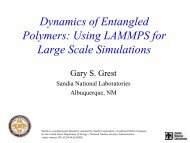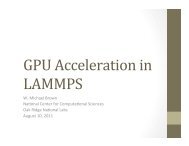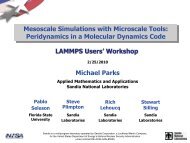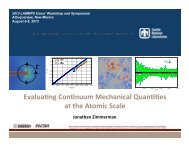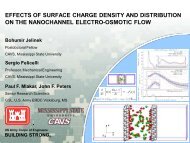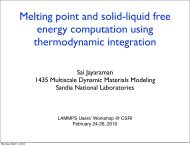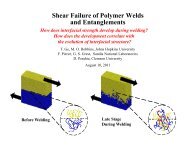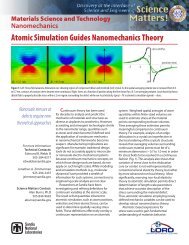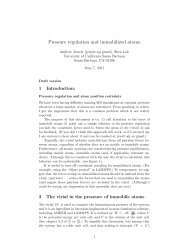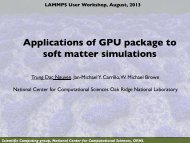Multiscale modeling of PECVD generated Silicon films ... - Lammps
Multiscale modeling of PECVD generated Silicon films ... - Lammps
Multiscale modeling of PECVD generated Silicon films ... - Lammps
You also want an ePaper? Increase the reach of your titles
YUMPU automatically turns print PDFs into web optimized ePapers that Google loves.
LAMMPS User Group MeetingAugust 7-8, 2013<strong>PECVD</strong> <strong>generated</strong> <strong>Silicon</strong> <strong>films</strong> withkinetic Monte Carlo and LAMMPSmolecular dynamicsDr. Andreas BickAlbuquerque, 2013
Motivation: <strong>Silicon</strong> is everywhere
Plasma Enhanced Vapor Deposition Chemical Reaction SiH 4-> Si + 2 H 2 Deposits thin <strong>films</strong> from a gas state (vapor) to a solid state on asubstrate Used for electronics, optoelectronics and photovoltaic applications Fast deposition at low temperatures Surface interactions and film growth not yet fully understood
Combine KMC and MDExperiment conditionsFullgrowthKMCStepwisegrowthKMCmap to atomisticmap to atomisticMDMDmap to KMCFilm properties
Kinetic Monte Carlo(n- fold method) Based on Diamond lattice Complex chemical reaction involving different radicalspecies Physisorptions & Chemisorptions <strong>of</strong> gas phase radicals Bulkilization <strong>of</strong> Hydrogen passivated Si Subsequent abstraction <strong>of</strong> surface atoms (Eley-Rideal HydrogenAbstractions) Surface diffusion <strong>of</strong> physisorbed radicals Two separate reaction steps (Decoupled diffusionmethodology) Diffusion (Markovian Random Walk) All the other reactions
Kinetic Monte Carlo(n- fold method) II At each step a complete list <strong>of</strong> possible reactions for allsurface sites is considered Reaction event j is randomly selected according to:Ri=M= ∑ i = 1ri∑i= j − 1i=jr( )i= 1 ii=1 i< ξ < 11R∑Rrwith the random number chi, the total number <strong>of</strong> possiblereactions per step M and the reaction rate r The time increment delta R is calculated asδ t = −ln( ξ )R22( )
KMC Results: Snapshot <strong>of</strong> KMC <strong>generated</strong> surface visualized in MAPS:
KMC Results: Surface thickness dependent on SiH content:5 % SiH 6 % SiH
KMC Results: Void distribution
Molecular Dynamics (LAMMPS) Newton’s equation <strong>of</strong> motionF =m a The force can be written as the gradient <strong>of</strong> the potentialenergyF =−∇ V Combine the two equations to getdVdr =−m d 2 rdt 2 A trajectory is obtained by solving this differentialequation NVT Simulations using the Nose Hover thermostat at 180K performed for this study
Ters<strong>of</strong>f Potential Bond Order Potential Strength <strong>of</strong> a chemical bond depends on the bondingenvironment, including the number <strong>of</strong> bonds and possiblyalso angles and bond length Exists in several modifications Implementation in LAMMPS needed modification to thefunctional form developed by Ohira( ) ⎡ ( ) ( )V = f r⎣a f r + b f rij C ij ij R ij ij A ijWhere the interaction parameter aij describes therepulsive Si-H interaction Implemented in LAMMPS for this project by Scienomics⎤⎦
Ters<strong>of</strong>f Potential Validation Reproducing structural characteristics: Si(100)–2x1 reconstruction Si(100)-2x1 reconstructed, H terminated Si-Si : 2.4 Å Si-H : 1.521 Å Si-Si-H : 111.9 degOhira et al, Phys. Rev. B, 52, 8283, 1995Ohira et al, Surface Science, 458, 216–228, 2000
LAMMPS MD Results: Convergence <strong>of</strong> total energy:Total Energy (MeV)-2.6-2.7-2.8-2.9-3.0-3.1Total Energy (MeV)-3.180-3.182-3.184-3.186-3.188DR=6%-3.1905.0 5.5 6.0 6.5time (ns)DR=6%Total Energy (MeV)-1.80-1.81-1.82Total Energy (MeV)-1.821-1.822-1.823DR=5%DR=5%-1.8246.0 6.5 7.0 7.5 8.0time (ns)-3.20 1 2 3 4 5 6 7time (ns)-1.830 1 2 3 4 5 6 7 8time (ns)
LAMMPS MD Results: Diffusion and Mean Square Displacement:4msd <strong>of</strong> film with DR=5%4msd <strong>of</strong> film with DR=6%3HSi3HSimsd2msd21100 2 4 6 8 10 1200 2 4 6 8 10 12t [ns]t [ns]DR = 5 % DR = 6 %
LAMMPS MD Results: Autocorrelation functions:1DR 5%1DR 6%ACF Si-Si0.90.82.0 A2.5 A3.0 A3.5 A4.0 A4.5 A5.0 A5.5 AACF Si-Si0.90.82.0 A2.5 A3.0 A3.5 A4.0 A4.5 A5.0 A5.5 A0.70 2 4 6 8 10 12 14 16t [ns]0.70 2 4 6 8 10 12t [ns]DR = 5 % DR = 6 %
LAMMPS MD Results: Bond Angle Distribution:0.6000Si-Si-Z angle : DR 5%0.0100Si-Si-Z angleP0.50000.40000.30000.2000P0.00800.00600.0040DR=5%DR=6%0.10000.00200.00000 20 40 60 80 100 120 140 160 180 200θ [deg]0.00000 20 40 60 80 100 120 140 160 180 200θ [deg]After MCAfter MD
LAMMPS MD Results: Bond Angle Distribution:
LAMMPS MD Results: Pair Correlation functions:
Figure 12 - Example Attack Tree for VPN partner connectionThe attack tree in Figure 12 is a horizontal tree that adheres to the guidelines discussed in the previoustree’s description. In this tree, the grey nodes are the conditional nodes <strong>of</strong> the tree, the red nodes areresultant conditions, green nodes are security controls and the orange nodes are threat actors/attackagents. This tree is shown as a comparison to the tree in Figure 11 – to illustrate the flexibility andcreativity possible with attack trees.Threat Pr<strong>of</strong>ilesFor the purposes <strong>of</strong> this paper, a threat pr<strong>of</strong>ile is defined as a tabular summary <strong>of</strong> threats, attacks andrelated characteristics. The tabular format allows for a large degree <strong>of</strong> flexibility in terms <strong>of</strong> the columnsand rows selected for each pr<strong>of</strong>ile. Threat pr<strong>of</strong>iles are an excellent tool for communicating the results <strong>of</strong>completed threat models and/or attack trees. They also allow for consolidation, sorting, pivoting and othercommon data manipulation functions. Providing detailed descriptions <strong>of</strong> both the cause and effect <strong>of</strong>threats and attack vectors is an ideal use case for threat pr<strong>of</strong>iles.For comparison, some assessment practices use the term threat pr<strong>of</strong>ile to describe a decomposition that ismuch more analogous to an attack tree [5], while others are more congruent with the description providedin this paper [13]. More recently, the term threat pr<strong>of</strong>ile has been used in the development <strong>of</strong> cyber threatintelligence.Table 2 presents a generic threat pr<strong>of</strong>ile template. Table 3, along with Listing 1, and Table 4 illustratecase study threat pr<strong>of</strong>iles. The differences in scope and applicability between Tables 3 and 4 are describedas follows: Table 3 is a more granular pr<strong>of</strong>ile and Table 4 is an example <strong>of</strong> a large-scale, detailed analysispresented as a summarized and aggregate data set. These two examples demonstrate the flexibility andscalability <strong>of</strong> threat pr<strong>of</strong>iles.© Lockheed Martin Corporation19
LAMMPS MD Results: Local Growth Zone in some detail
LAMMPS MD Performance with modifiedTers<strong>of</strong>f potential: Execution time over 10000 MD steps System size 965902 atoms, 80000 fixed NVT with PBC in xand yExecution time (s)250020001500100050000 200 400 600 800 1000 1200Number <strong>of</strong> CoresParallel Efficiency (%)1009590850 200 400 600 800 1000 1200Number <strong>of</strong> Cores
Classical Engines & Tools in MAPS
Monte Carlo based Tools
Scienomics LAMMPS additions Ters<strong>of</strong>f with repulsive three body interactions(ters<strong>of</strong>f/rep) – will be committed soon Bond angle: fourier, fourier/simple, quartic Dihedral: quadratic, nharmonic Improper: fourier
Conclusions <strong>Silicon</strong> <strong>films</strong> growth by <strong>PECVD</strong> modeled using KMCcombined with MD With KMC: overcome the problem <strong>of</strong> multiple time scales <strong>of</strong> the reactionsinvolved in the process good qualitative prediction <strong>of</strong> the deposition rate for a range <strong>of</strong>conditions good qualitative prediction <strong>of</strong> the final composition in H for a range<strong>of</strong> conditions Film thickness <strong>of</strong> several 10 nm simulated With the MD simulations we target: Relaxation <strong>of</strong> the <strong>films</strong> produced from KMC Gradual relaxation <strong>of</strong> the film as it is developed fro KMC Study the molecular mechanisms relevant to properties such ascrystallinity and surface roughness
Thank you for yourattentionContact:Andreas.Bick@scienomics.comVisit: www.scienomics.com


